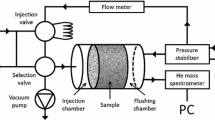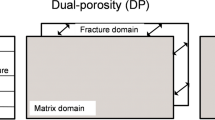Abstract
Effective porosity value was analyzed from the tritium concentration of sampled groundwater using a three-dimensional groundwater-flow and advection-dispersion code based on the finite element method. The effective porosity value was about 10%. Porosity values measured from core samples were 7–15%. The groundwater flow velocity estimated from the tritium concentrations was about 1 × 10−5 cm s−1. Therefore, during the low groundwater flow velocity condition, effective porosity and porosity values were the same. At the same test site, a 0.48% effective porosity value, determined by another tracer test injecting Br− solution into the aquifer during groundwater level change, was smaller than the porosity value when the flow velocity was 1.8×10−2 cm s−1. Thus the effective porosity value is concluded to be due to groundwater flow velocity. The specific yield value was calculated to be 0.6% by the total volume of tunnel seepage water and the total volume of the rock unsaturated during tunnel construction. However, as pore water continued to be drained after the groundwater level change was completed, the specific yield value became larger than 0.6%. Thus specific yield value is concluded to be due to drainage time.
Similar content being viewed by others
References
Eckis R (1934) South Coastal Basin investigation, geology and groundwater storage capacity of valley fill,Bulletin 45, California Division of Water Resources, Sacramento, 279 pp
Freeze RA and Cherry JA (1979)Groundwater. Englewood Cliffs, New Jersey: Prentice-Hall, 604 pp
Ii H (1995) Effective porosity and longitudinal dispersivity of sedimentary rocks determined by laboratory and field tracer tests. J Environ Geol 25(2):71–85
Ii H and Misawa S (1994) The groundwater chemistry within a plateau neighboring Matsumoto city, Japan. J Environ Geol 24(3):166–175
Ii H, Ishikawa Y, Sugihara K, and Utsugida Y (1993) Estimation of scale effect on effective porosity and longitudinal dispersivity of a Tertiary sedimentary rock by laboratory tracer tests and a field tracer test. Hannover: International Association of Hydrogeologists. pp 153–162
Ii H, Misawa S, and Kawamura R (1994) Effective porosity, longitudinal dispersivity and hydraulic conductivity of a sedimentary formation determined by field tracer testing, three-dimensional groundwater flow and advection-dispersion FEM. Proceedings of the 7th congress of the International Association of Engineering Geology. Rotterdam: A. A. Balkema, pp 4213–4221
International Atomic Energy Agency (1983) Isotope techniques in the hydrogeological assessment of potential sites for the disposal of high-level radioactive waste. IAEA, Vienna: Technical Reports Series. No. 228, 151 pp
Kawamura R (1987) Three-dimensional groundwater flow and advection diffusion code for treating decay chain of radioactive materials by finite element method. J Nucl Sci Technol 24(11):937–950
Linsley RK, Kohler MA, and Pauthus JLH (1958)Hydrology for engineers. New York: McGraw-Hill
Marsily G (1986)Quantitative hydrogeology. Orlands, Florida: Academic Press. 440 pp
Motojima I (1993) Study on groundwater around the underground cavern by isotopes of oxygen (18O), hydrogen (D,3H) and radon (222Rn) in groundwater. J Groundwater Hydrol 35(3):185–200
Pickens JF and Grisak GE (1981a) Scale-dependent dispersion in a saturated granular aquifer. Water Resour Res 17(4):1191–1211
Pickens JF and Grisak GE (1981b) Modeling of scale-dependent dispersion in hydrogeologic systems. Water Resour Res 17(6):1701–1711
Todd DK (1959)Hydrology. New York: John Wiley & Sons, 336 pp
Author information
Authors and Affiliations
Rights and permissions
About this article
Cite this article
Ii, H., Ohtsuka, Y., Mori, N. et al. Effective porosity and specific yield of a sedimentary rock determined by a field tracing test using tritium as a tracer. Geo 27, 170–177 (1996). https://doi.org/10.1007/BF00770429
Received:
Accepted:
Issue Date:
DOI: https://doi.org/10.1007/BF00770429




